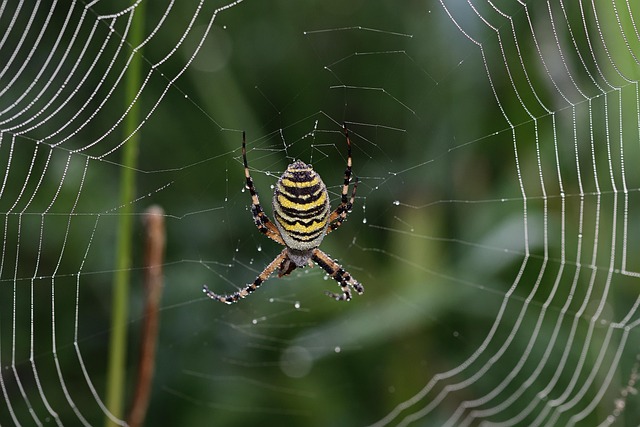Understanding spider behavior and habitat preferences is key to preventing infestations. Homeowners should inspect high-risk areas like dark, hidden spaces, basements, attics, and areas with poor ventilation or moisture issues. Professionals use advanced techniques for comprehensive inspections, focusing on webs, egg sacs, and heat signatures. Proactive measures include sealing entry points, using screens, regularly cleaning, and minimizing clutter to reduce hiding places and food sources.
“Uncovering the secrets of spider-prone areas is key to effective spider infestation prevention. This comprehensive guide delves into the world of these arachnid intruders, helping you identify high-risk zones and understand their behavior. We’ll explore powerful inspection techniques and tools to detect their presence early. By implementing sealing measures after thorough inspections, you can fortify your space against spiders, ensuring a safer environment. Discover practical steps for spider infestation prevention and reclaim your living spaces.”
Understanding Spider Behavior and Habitat Preferences
Understanding the behavior and habitat preferences of spiders is key in implementing effective spider infestation prevention strategies. Spiders are arachnids with a diverse range of species, each exhibiting unique behaviors and seeking specific habitats. Some prefer dark, secluded corners while others thrive in moist environments or areas with abundant prey. Common household spiders, such as the house spider (Parasteatoda tepidariorum), often reside in attics, crawl spaces, and wall voids, where they can easily access food and remain hidden.
By knowing these preferences, homeowners and professionals can proactively identify potential spider-prone areas. Regular inspections should focus on less accessible places like cracks, crevices, and corners, as well as areas with high humidity or the presence of prey items like insects. Preventative measures, such as sealing entry points, maintaining proper ventilation, and reducing potential food sources, can significantly deter spiders from establishing infestations.
Identifying High-Risk Areas for Spider Infestations
When it comes to preventing a spider infestation, identifying high-risk areas is the first step. Spiders are naturally drawn to dark, hidden spaces where insects and other prey are abundant. Therefore, areas that are less accessible or often overlooked in your home or building can become breeding grounds for spiders. Common high-risk zones include basements, attics, behind appliances, under sinks, and cracks in walls or ceilings. Regularly checking these spots during thorough inspections is crucial for spider infestation prevention, as early detection can make a significant difference in effectively managing and controlling the problem.
Additionally, paying close attention to areas with poor ventilation or where moisture issues exist can be beneficial. Spiders are attracted to humid environments, so bathrooms, kitchens, and laundry rooms might require extra scrutiny. Ensuring proper maintenance, sealing entry points, and keeping these spaces well-ventilated and dry can significantly reduce the likelihood of a spider infestation. Regular inspections should also include outdoor areas, such as gardens and garages, where spiders may enter from nearby vegetation or hidden corners.
Comprehensive Inspection Techniques and Tools
Comprehensive inspections are key to identifying areas prone to spider infestations, a critical step in effective spider infestation prevention. Professionals employ a range of techniques and tools to ensure no nook or cranny is left unexamined. These include visual inspections, where carefully trained eyes scan for webs, egg sacs, and adult spiders. High-resolution cameras with zoom capabilities offer a closer look without disturbing potential nests.
Moreover, thermal imaging technology detects heat signatures, helping identify hidden spiders and their shelters. In inaccessible areas, long-handled brushes and suction devices are used to gently dislodge spiders from narrow crevices and hard-to-reach surfaces. Regular cleaning and decluttering significantly aid in spider infestation prevention, eliminating hiding places and reducing potential food sources.
Preventive Measures to Seal Out Spiders Post-Inspection
After identifying areas prone to spider infestations through thorough inspections, it’s crucial to take proactive steps to seal out spiders and prevent future invasions. The first line of defense involves sealing entry points such as gaps in walls, floors, and ceilings. Use caulk or weatherstripping to fill cracks and crevices where spiders might enter. Ensuring windows are fitted with tight-fitting screens and that doors have sweep seals can significantly reduce the risk of spiders finding their way inside.
Regular cleaning and maintenance are also vital for spider infestation prevention. Dusting and vacuuming regularly, especially in corners and along baseboards, helps remove webs and deter spiders. Keeping the home cluttered to a minimum reduces hiding places for arachnids. Additionally, storing items in airtight containers can prevent spiders from accessing potential food sources or hiding spots.
In conclusion, effective spider infestation prevention starts with understanding these arachnids’ behavior and preferences. By thoroughly inspecting your property and identifying high-risk areas, you can employ targeted strategies using suitable tools. Implementing preventive measures after the inspection ensures a robust defense against spiders, providing lasting peace of mind in a spider-free environment.
